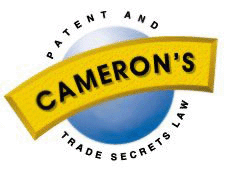
Case Comment
Reeves Brothers Inc. v.
Toronto Quilting & Embroidery Ltd.
citation(s): (1978), 43 C.P.R. (2d) 145 (F.C.T.D. per Gibson J.)
 Case Comment |
Reeves Brothers Inc. v.
|
copyright 2007 Donald M. Cameron
As I understand it, in order that there may be a finding of anticipation, the prior art must (1) give an exact prior description; (2) give directions which will inevitably result in something within the claims; (3) give clear and unmistakable directions; (4) give information which for the purpose of practical utility is equal to that given by the subject patent; (5) convey information so that a person grappling with the same problem must be able to say "that gives me what I wish"; (6) give information to a person of ordinary knowledge so that he must at once perceive the invention; (7) in the absence of explicit directions, teach an "inevitable result" which "can only be proved by experiments"; and (8) satisfy all these tests in a single document without making a mosaic. These tests are enunciated in the following cases: Steel Co. of Canada Ltd. v. Sivaco Wire & Nail Co. (1973), 11 C.P.R. (2d) 153 at pp. 189- 92; Pope Appliance Corp. v. Spanish River Pulp & Paper Mills Ltd. (1929), 46 R.P.C. 23 at p. 54; Lovell Mfg. Co. and Maxwell Ltd. v. Beatty Bros. Ltd. (1962), 41 C.P.R. 18 at pp. 45-8, 23 Fox Pat. C. 112; General Tire v. Firestone, [1971] F.S.R. 417 at p. 444; British Thompson-Houston Co. Ltd. v. Metropolitan-Vickers Electrical Co. Ltd. (1928), 45 R.P.C. 1 at pp. 22-4; Letraset Int'l Ltd. v. Dymo Ltd., [1976] R.P.C. 65 at p. 75; Xerox of Canada Ltd. et al. v. IBM Canada Ltd. (1977), 33 C.P.R. (2d) 24 at pp. 46-8 and 49.
Return to:
Cameron's IT Law: Home Page; Index
Cameron's Canadian Patent & Trade Secrets Law: Home Page; Index